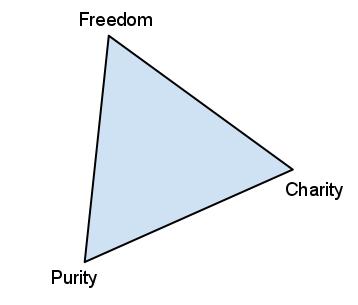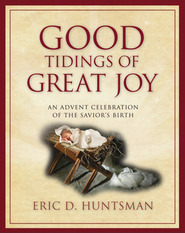-
•
•
5 responses

(part 1 of 4) A strange autumn. The gold harvest sky, usually so calm and calming, is full of unrest. Nervous pigeons cluster near the freeway overpass. Above them circle the gulls, those inland outlanders who should be pulling fish from the sea. Nameless small dark birds coalesce into rolling, chattering clouds before dropping to roost on rooftops and treetops and utility wires. Read More
-
•
•
19 responses

Yesterday I dedicated the grave of my grandfather, Verl Bagley, who by one measure spent his life at the end of the earth. Read More
-
•
•
One response

The first Institute class held in our upper Manhattan apartment in 1988 explored Mormon philosophy and intellectual life. The readings included a 1969 Dialogue article by Leonard Arrington, “The Intellectual Tradition of the Latter-day Saints,” (pdf) which mentioned a questionnaire Arrington had sent to 50 Mormon intellectuals asking them to list the five most eminent intellectuals in Mormon History. I was then surprised to find Parley P. Pratt on that list. Read More
-
•
•
39 responses
We opened nominations for Mormon of the Year 2011 on December 9th. To keep everyone up to date, here are the nominations so far. Nominations remain open through December 31st, and a public vote on the candidates will begin January 1st. Feel free to make additional nominations or second any of those that have not yet been seconded, if you think they are worthy. Read More
-
•
•
26 responses
A thought inspired by Aquinas’ review, which focuses on the teacher, instead of the manual. If I had any Photoshop skills, I’d have put the manual in the middle of that ring. Reference comes from Aquinas’ post. I taught the Teacher Training course for a few months earlier this year, which meant I spent a lot of time with Teaching:No Greater Call. I discovered an important and surprisingly subversive story p. 214-15, presented below with minor editorializing in brackets and bolding. “In our new ward my husband and I discovered that the Gospel Doctrine class [read: the teacher] wasn’t very… Read More
-
•
•
19 responses
Christmas is awesome as a kid because you get cool stuff that you can’t get any other time. (Yeah, yeah, you can tell me that Christmas is awesome because we celebrate the Savior’s birth or because we get to serve people, but if you were a kid like I was a kid, it really just came down to presents and time off school.) Now here’s my “kinds of presents” list: Stuff the recipient doesn’t want (like Christmas ornaments — who ever thinks, “I’d love a Christmas ornament”?) Stuff the recipient likes and would probably get for themselves anyway (like clothes)… Read More
-
•
•
97 responses

FOX News was on while I stood in line at McDonald’s last night. I noticed that the guy being interviewed looked distinctly Mormon (apparently we have a distinctive look), so I walked over to see what was up. The guest was Connor Boyack, and he was talking about how, of all the political ideologies, Mormonism is most compatible with Libertarianism. The Mormon-Libertarian connection is nothing new, but it fits in with something that’s been on my mind lately — competing “goods”. Or, in Elder Oaks’ words, “good, better, and best”. As I see it, there are three cardinal points of political virtue… Read More
-
•
•
35 responses
You can read the study itself here or a summary of it in the DN here. Read More
-
•
•
83 responses
The Church announced that it has released a revised Strength of Youth pamphlet. Read More
-
•
•
30 responses
Joseph Spencer, in his encouraging response to Taylor Petrey’s Dialogue article, “Toward a Post-Heterosexual Mormon theology,” makes the following claim: Read More
-
•
•
48 responses

The long-delayed NBA pre-season starts Friday, much to the delight of the nation, and, of course, the Jimmer Fandom (Jimmermaniacs?). And as I reviewed the information I’ve clipped about Mormons in basketball, I faced a surprising conclusion: Jimmer is the only Mormon currently playing in the NBA. Could that be right? If it isn’t, I’d love to know. And if it is, perhaps that is a reason for Jimmer to be named Mormon of the Year? Read More
-
•
•
24 responses

We’re nearing the end of our New Testament study for the year; what have we learned? Shall we assess? Back in 2006, when I was still engaged in my Sisyphian PhD pursuit, I taught an Honors Acts-Revelation class at BYU, which was a lot of fun. We learned a little Greek, read some introductory scholarship, and the New Testament in two translations. Students had an outside assignment each week, and a reading assignment for each class period on top of the New Testament passages. Generally speaking, students responded very positively. On the very first day, we learned the Greek alphabet,… Read More
-
•
•
16 responses
So I wrote a book. Not a Mormon book, but one in my academic field. I’ve been working on the book since just before my youngest daughter was born. She started first grade in September, and the book was published last week. The idea for the book came to me in 2005, Read More
-
•
•
5 responses

Eric D. Huntsman, Good Tidings of Great Joy, October 2011, Deseret Book, 166 pages. Read More
-
•
•
48 responses
Its that time of year again. The media will soon start reviewing the important news stories of the year, Time will soon select its Person of the Year; so we should get busy selecting the Mormon of the Year. For those who don’t remember, T&S selected Mitt Romney as the Mormon of the Year for 2008, Harry Reid for 2009, and Elizabeth Smart for 2010. As in the past, the choice does not mean that the person is a good Mormon or even a good person. This designation is solely about the impact the person has had. Note: We have made… Read More
-
•
•
16 responses
Terryl L. Givens and Matthew J. Grow, Parley P. Pratt: The Apostle Paul of Mormonism, Oxford University Press, October 2011, 521 pages. Read More
-
•
•
4 responses
Starting tomorrow and extending for several weeks, several of my co-bloggers and I will post reviews of Parley P. Pratt: The Apostle Paul of Mormonism by Terryl L. Givens and Matthew J. Grow, which was published a few months ago by Oxford University Press. Read More
-
•
•
9 responses

Unfortunately inspired by a personal experience related to me recently, I present a rebuke of sorts and a call for more Christ-like compassion by Elder Holland. “When a battered, weary swimmer tries valiantly to get back to shore, after having fought strong winds and rough waves which he should never have challenged in the first place, those of us who might have had better judgment, or perhaps just better luck, ought not to row out to his side, beat him with our oars, and shove his head back underwater. That’s not what boats were made for. But some of us… Read More
-
•
•
6 responses
A Japanese former ambassador to China recently offered some provocative thoughts on the global promise of America, suggesting that the American melting pot is a kind of pilot project for world peace. Could the same be true of the LDS Church? Read More
-
•
•
22 responses
“Why didn’t I know about this?” She sounds angry. Read More
-
•
•
12 responses
Nauvoo had its Relief Society, but the “society of sisters” in Boston was instead the “Sewing and Penny Society,” or so the Church’s New York City newspaper reported. Despite all that the Relief Society has become in the nearly 170 years since it was founded, it apparently only existed in Nauvoo. In other areas, women were left to their own devices. Read More
-
•
•
41 responses
A three-part quiz: 1. Please review the account of Korihor in Alma 30. 2. True or false: Korihor was a religious freedom advocate battling an oppressive central government. 3. What does your answer in #2 say about these areas? Pick a few, and elaborate: -The role of religion in public life -The place of religious freedom claims -Free speech and its potential limitations -Popular conceptions about the proper role of government in 1830 (or in 2011) -Democracy, theocracy, and Zion -Any related topics of interest Read More
-
•
•
65 responses
A few weeks ago two Evangelical scholars authored “The Evangelical Rejection of Reason,” an op-ed at the New York Times lamenting the fact that the Republican primary race “has become a showcase of evangelical anti-intellectualism.” While the Mormons in the race, Romney and Huntsman, were described as “the two candidates who espouse the greatest support for science,” the discussion still invites the LDS reader to reflect a bit on whether there is a similar strain of LDS anti-intellectualism evident in LDS culture if not in LDS presidential candidates. Read More
-
•
•
30 responses
Regular T&S readers will have noticed that our site has not been available for much of the past couple of days. Its not our fault. On Thursday morning, Bluehost.com, our now former host, shut down our site without warning and without providing any specific information that might allow us to solve whatever problem had arisen.We are not pleased and, frankly, we expected more of a company based in a heavily Mormon area. So we have taken the opportunity to switch hosts, and we are upgrading our software in the process. All of our content has been recovered and all of… Read More
-
•
•
3 responses
Patrick Mason is studying the effect of the bloggernacle on Mormon Studies, has put together a questionnaire, and is seeking responses from graduate students. Here is a preface from Dr. Mason, the Howard W. Hunter Chair of Mormon Studies at Claremont Graduate University: At the January 2012 meeting of the American Society for Church History, I’ll be on a panel called “Teaching Mormonism in a Digital Age.” In my comments I’ll be considering the impact of the “bloggernacle” on Mormon studies, specifically in regard to the current generation of graduate students. I have designed the following questionnaire to get a… Read More
-
•
•
8 responses
Here’s my wild-eyed claim for the day: religion is about the world, not about religion. Which do you talk about at church? Read More
-
•
•
16 responses
About a week ago, James posted a reflection on Harold Bloom’s (frankly awful) New York Times op-ed. Rather than directly responding, though (other than expressing his rightful disappointment), James engaged with Dr. Bloom’s allegation that Mormonism and Protestantism are converging. Though concerned about such a convergence, James ultimately (and rightly, I believe) doesn’t think we’re headed inexorably down that path. That said, Dr. Bloom is right that the Church has changed a lot between 1844 and 2011.[fn1] Change is inevitable and, as Ecclesiastes tells us, is to be expected. And, frankly, there have been a number of changes that, even… Read More
-
•
•
37 responses
Say we agree that Mormonism is about progress and progression. A couple of questions might follow. Read More
-
•
•
22 responses
Depression played a major role in my self-identity for a decade of my life, from about 7th grade through the end of my mission. Life is good. In fact, life is great now. I’ve worked through my demons. No, that makes it sound like I knew what I was doing. Even now I can’t say why things have turned out as well as they have. Just lucky, I guess. I remember the day I decided to be lucky. I was walking to school with a friend on one of those frigid mornings when you can see your breath. Things hadn’t… Read More
